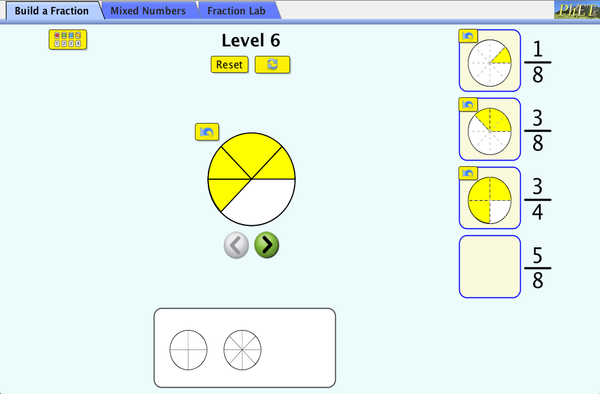Topics
- Fractions
- Equivalent Fractions
- Mixed Numbers
Description
Build fractions from shapes and numbers to earn stars in this fractions game or explore in the Fractions Lab. Challenge yourself on any level you like. Try to collect lots of stars!
Sample Learning Goals
- Build equivalent fractions using numbers and pictures
- Compare fractions using numbers and patterns
- Recognize equivalent simplified and unsimplified fractions
- Note: Build A Fraction expands on ideas from the Fraction Intro and Fraction Matcher sims or can be used as a stand-alone tool
Standards Alignment
Common Core - Math
1.G.A.3
Partition circles and rectangles into two and four equal shares, describe the shares using the words halves, fourths, and quarters, and use the phrases half of, fourth of, and quarter of. Describe the whole as two of, or four of the shares. Understand for these examples that decomposing into more equal shares creates smaller shares.
2.G.A.2
Partition a rectangle into rows and columns of same-size squares and count to find the total number of them.
2.G.A.3
Partition circles and rectangles into two, three, or four equal shares, describe the shares using the words halves, thirds, half of, a third of, etc., and describe the whole as two halves, three thirds, four fourths. Recognize that equal shares of identical wholes need not have the same shape.
3.G.A.2
Partition shapes into parts with equal areas. Express the area of each part as a unit fraction of the whole. For example, partition a shape into 4 parts with equal area, and describe the area of each part as 1/4 of the area of the shape.
3.NF.A.1
Understand a fraction 1/b as the quantity formed by 1 part when a whole is partitioned into b equal parts; understand a fraction a/b as the quantity formed by a parts of size 1/b.
3.NF.A.2
Understand a fraction as a number on the number line; represent fractions on a number line diagram.
3.NF.A.2a
Represent a fraction 1/b on a number line diagram by defining the interval from 0 to 1 as the whole and partitioning it into b equal parts. Recognize that each part has size 1/b and that the endpoint of the part based at 0 locates the number 1/b on the number line.
Version 1.02










